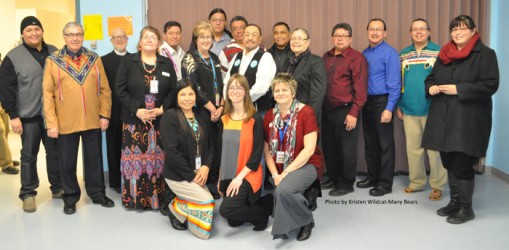Article Origin
Volume
Issue
Year
Members of the Aboriginal community will now feel more comfortable when receiving medical treatment at the Wetaskiwin Hospital and Care Centre. A room recently opened in the hospital is dedicated to honouring and respecting traditional Aboriginal beliefs about health.
“It’s a huge step forward because in allowing them to pray and to do ceremony, we are acknowledging that part of our spiritual well-being,” said Tracy Lee, the Aboriginal health lead for the Alberta Health Services central zone. “For us, health is holistic... emotional, mental, spiritual and physical. Now we have space where we can honour that.”
The room, opened in early February, is the result of a collaborative effort between Alberta Health Services, the Aboriginal health program, the Wetaskiwin hospital and the Maskwacis Health Services. Families can use it 24 hours a day, seven days a week. It is a small space with a couch and chairs, decorated with paintings donated by the Maskwacis Health Services by First Nations artists. The room is specially ventilated and sweetgrass will be available by request. Daily smudges, to be announced over the intercom, will be open for everyone.
The room acts as a bridge between the First Nations community and mainstream health care, says Lee. In the Maskwacis community, for example, there are no primary healthcare services, such as hospitals or emergency walk-in clinics, and doctors on-reserve are few. People are forced to seek medical treatment off-reserve, but they don’t always feel welcomed.
“Providing a culturally appropriate base will contribute to better relationships between the healthcare providers and the Aboriginal population. It’s only going to increase cultural competency, and increased cultural competency contributes to providing a culturally safe environment,” said Lee.
Irvin Bull, chairperson for the Maskwacis Health Services, played a key role in initiating the request for the room. Bull says many members from Maskwacis mentioned how difficult it was to maintain their traditions while accessing health care in other communities.
“They’d have to request to have a smudge or light sweetgrass, and they’d have to go through a process where they had to close the vent or shut off the fire alarms,” he said.
But while the most recent request for the room was submitted last October, there was talk of a room as early as 1982. “Way back then” the county of Wetaskiwin used the Maskwacis population as part of their own population statistics to access healthcare funding from the federal government, so it’s been a long time in the making, says Bull.
“It took 34-years, but we got one, and that’s the main thing,” he said.
Randy Littechild, health director for the Maskwacis Health Services, wrote the October proposal for the room. He submitted one to the Ponoka Hospital and Care Centre at the same time, and that hospital is still trying to find the space, he says.
“We’re making a lot of progress with the hospitals in general,” said Littlechild. “All I can say is, there’s a better collaboration between the whole AHS in the central zone than there was 10 years ago. We sit down regularly and meet and discuss things.”
Photo Caption: Representatives from Ermineskin, Samson, Louis Bull and Montana Cree Nations were joined by personnel from Westaskiwin hospital, Maskwacis Health Services, and Alberta Health Services to celebrate the opening of an Aboriginal cultural room at the Wetaskiwin Hospital and Care Centre on Feb. 5.
- 1598 views

